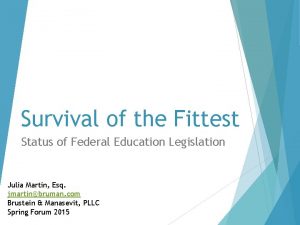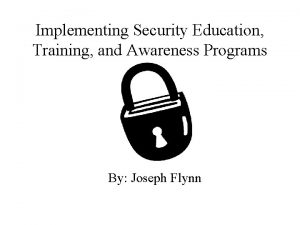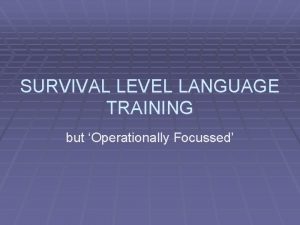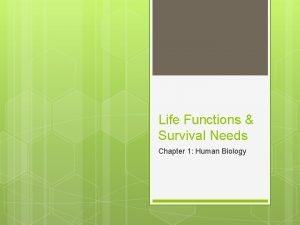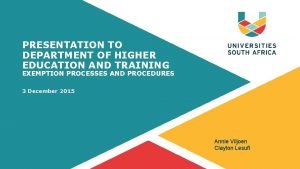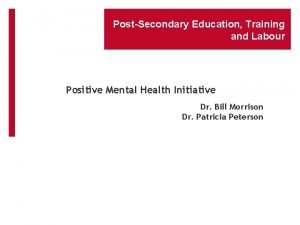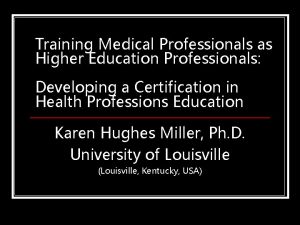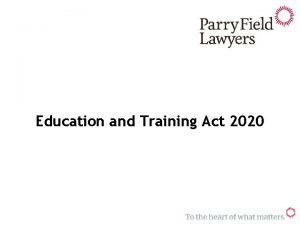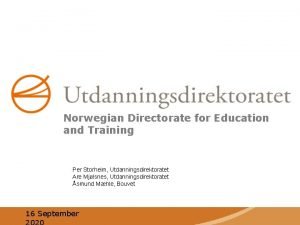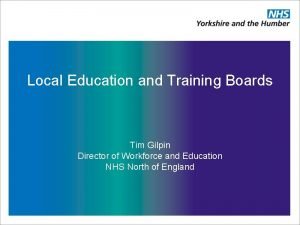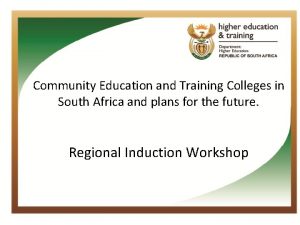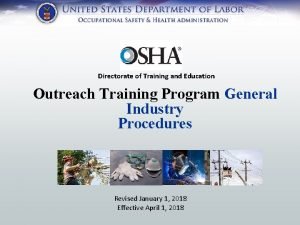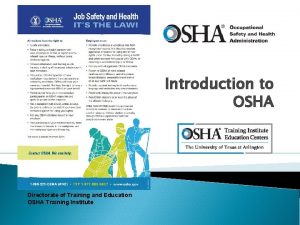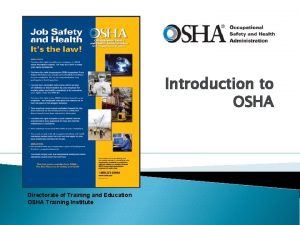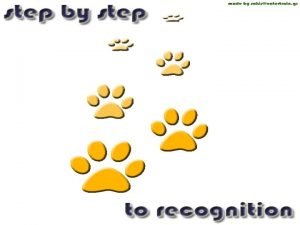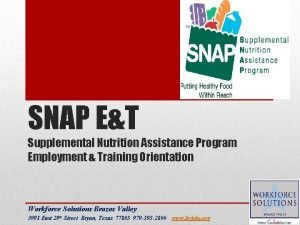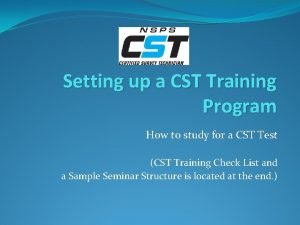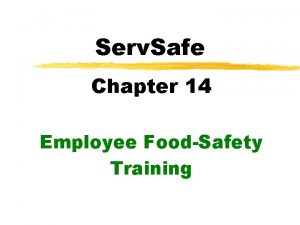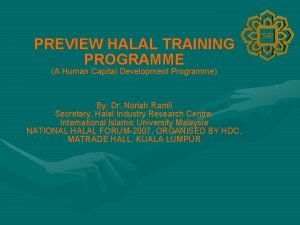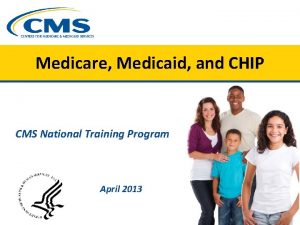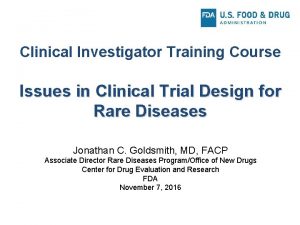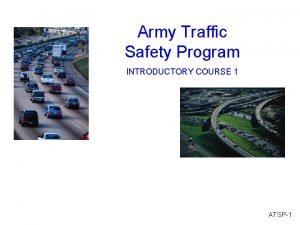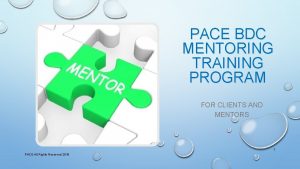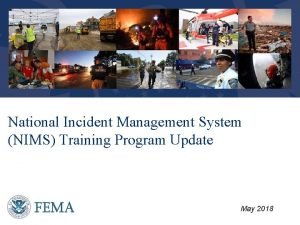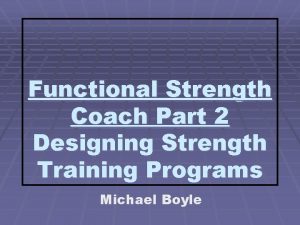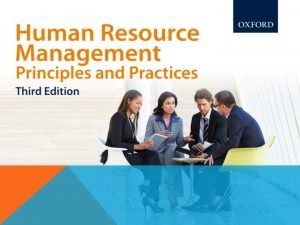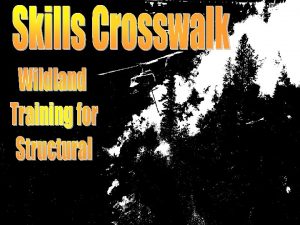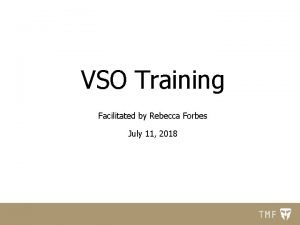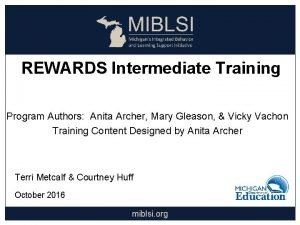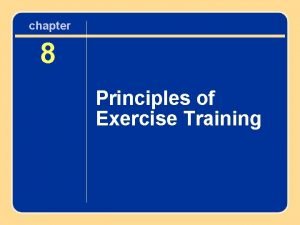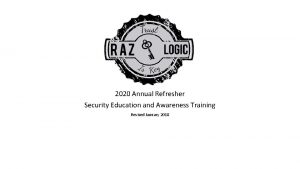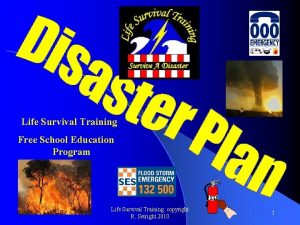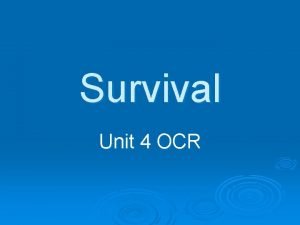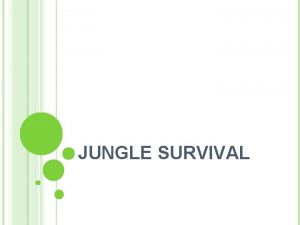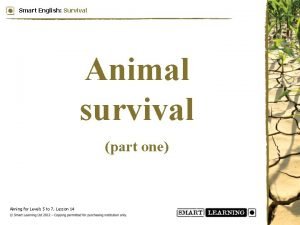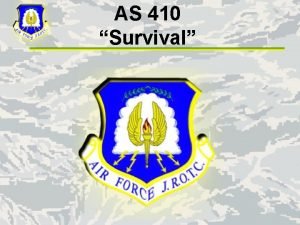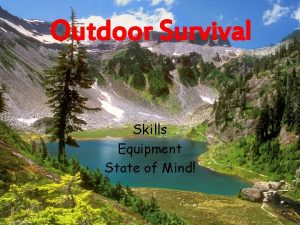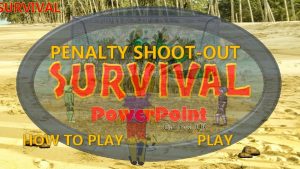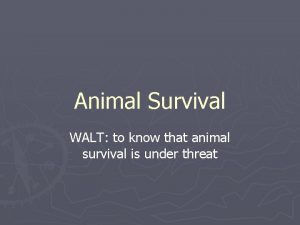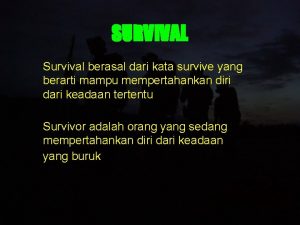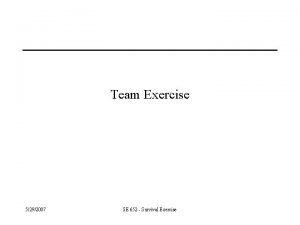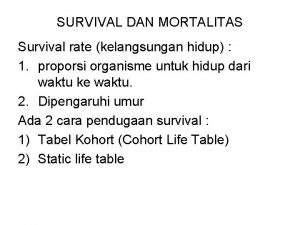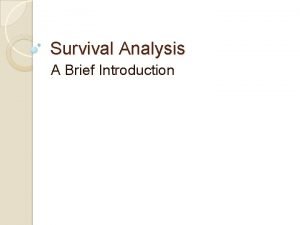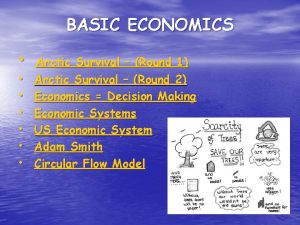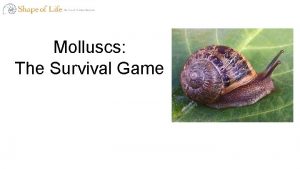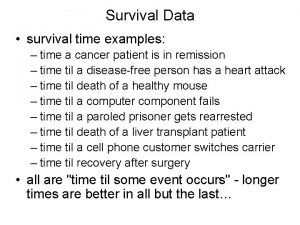Life Survival Training School Education Program Life Survival

















































- Slides: 49

Life Survival Training School Education Program Life Survival Training. copyright R. Setright 2010 1

What Can We Do? l l l Make sure you get the day off School during severe weather warnings (Flood, Fire or Storm), in your area. Watch for situations that could be dangerous and report them. Make plans so emergency services SES, Police and Fire Brigade can respond to dangerous situations in your area. Tell other people what is happening, and what they can do. Tell a family member or friend OUTSIDE of your area what is happening. Know how to save lives. Learn First Aid and CPR Life Survival Training. copyright R. Setright 2010 2

Types of Emergencies l l l l Cyclones Earthquakes Tornadoes Floods Fire Winter Storms Severe Thunderstorms Life Survival Training. copyright R. Setright 2010 3

Life Survival Training. copyright R. Setright 2010 4

Cyclones Australia is often affected by cyclones and wind storms. l In 1974 cyclone Tracy struck our coastline causing severe damage and loss of life throughout a large part of Darwin NT. l Cyclone Tracy Darwin Life Survival Training. copyright R. Setright 2010 5

What is a Cyclone? A cyclone is a tropical storm with winds greater than 120 km per hour. l Cyclones have a spiral shape, like a pinwheel. At the centre of a cyclone/hurricane is a calm area 30 to 45 km wide called the eye. l Cyclones cause damage through: high winds, heavy rain, storm surge, and flooding. l Cyclone season November to March in the northern parts of Australia. l Life Survival Training. copyright R. Setright 2010 6

Cyclone Preparedness Keep up with reports on the television, radio, and computer about the cyclone. l Discuss a family cyclone plan with your parent or guardian, and have a disaster kit ready. l Know the difference between a cyclone watch: watch a cyclone may strike in 24 -36 hours; and a cyclone warning: warning a cyclone will be in your area within 24 hours. l Evacuate as soon as notice is given. l Life Survival Training. copyright R. Setright 2010 7

If You Can’t Leave l l l l Board up or tape all windows. Fasten down any loose materials inside and outside of your home and close all doors. Move cars from under trees. Let the SES and Police know that you are there. Stay indoors in a central room close to the floor. Listen to the radio for updates. Have your disaster kit ready. Bring pets inside. Life Survival Training. copyright R. Setright 2010 8

Life Survival Training. copyright R. Setright 2010 9

Earthquakes l Australia has several quakes annually. Typical earthquakes are mild ranging from 1. 0 to 3. 0 in magnitude, with some earthquakes exceeding 5. 5 Newcastle Earthquake 1989 Life Survival Training. copyright R. Setright 2010 10

What is an Earthquake? l An earthquake is the shockwave that occurs when plates beneath the Earth’s crust shift. This movement causes the ground to become unstable causing buildings to collapse. Life Survival Training. copyright R. Setright 2010 11

Australian Earthquakes Newcastle has had significant earthquakes. l A severe quake in 1989 caused millions of dollars in damage and loss of life. l Newcastle NSW 1989 Life Survival Training. copyright R. Setright 2010 12

Earthquake Preparedness Identify danger areas. Do not go near glass that could break, or heavy objects that could fall on you during an earthquake. l Move to a safe place where you can get under a table, desk, or against an interior wall. l Practice Drop, Cover, and Hold On drills. l Discuss your emergency plan with parents and teachers, have your disaster kit ready. l Life Survival Training. copyright R. Setright 2010 13

Earthquakes recorded in Australia Number of earthquakes recorded in Australia from 2000 – 31/12/2009: l l l l l By State: WA NT SA QLD NSW ACT VIC TAS 2296 252 354 48 382 6 225 34 l TOTAL 3597 Life Survival Training. copyright R. Setright 2010 14

Life Survival Training. copyright R. Setright 2010 15

The most important information that can be given is to listen to the radio and keep in contact with your local Fire Brigade, Rural Fire Brigade (Services), Police and SES. They will give you important information about fire movement, danger in your area and what you need to do. l Ring 000 or 112 (from mobile phones) if you need emergency help in a fire. Do not use this service for general information. l Life Survival Training. copyright R. Setright 2010 16

Fire Safety Steps l l l l Follow the advice of emergency services. Be aware of bushfires in your area. Make sure you: Watch the weather and monitor the radio for news of a fire’s progress. Organise yourself well in advance and pre-pack. In case of relocation dress in protective clothing NOT nylon. Wear wool or cotton and boots NOT thongs. Drink water frequently. If in immediate danger, call 000 (or 112 from mobile phones) for help. Life Survival Training. copyright R. Setright 2010 17

Prepare Your Home The NSW RFS promote the philosophy “Prepare, Act, Survive”. l Homes are more likely to survive if they are well prepared: l – Clean leaves and dead fall from the roof, gutters, downpipes and around the home. – If you have water tanks or a swimming pool, be able to access this water. – Remove combustible material from around the house such as overhanging trees, dead fall, leaves, old timber, fuels. – Install a working smoke alarm. l Know the fire danger ratings and how to act.

Fire Safety Steps 1. Stay Low l If you can see smoke in the house, stay low to the ground as you make your way to the exit. In a fire, smoke and poisonous air hurt more people than the actual flames do. You'll breathe less smoke if you stay close to the ground. Smoke naturally rises, so if there is smoke while you're using your escape route, stay low. l You can drop to the floor and crawl on your hands and knees below the smoke. Life Survival Training. copyright R. Setright 2010 19

Fire Safety Steps l 2. If caught out in the open dig a hole as long as yourself and at least as deep as your body. Lay in this and cover yourself with fire blankets and don a smoke face mask. Remember you usually can not outrun an oncoming fire. Once the fire has passed move to the burnt out area. Life Survival Training. copyright R. Setright 2010 20

Fire Safety Steps l l l 3. If you're in a room with the door closed when the fire breaks out, you need to take a few extra steps: Check to see if there's heat or smoke coming in the cracks around the door. (You're checking to see if there's fire on the other side. ) If you see smoke coming under the door — don't open the door! If you don't see smoke — touch the door with the back of your hand. If the door is hot or very warm — don't open the door! Life Survival Training. copyright R. Setright 2010 21

Fire Safety Steps l If you don't see smoke — and the door is not hot — then use your fingers to lightly touch the doorknob. If the doorknob is hot or very warm — don't open the door! l If the doorknob feels cool, and you can't see any smoke around the door, you can open the door very carefully and slowly. When you open the door, if you feel a burst of heat, or smoke pours into the room, quickly shut the door and make sure it is really closed. If there's no smoke or heat when you open the door, go toward your escape route exit. Life Survival Training. copyright R. Setright 2010 22

Fire Safety Tips l 4. Have regular fire safety practise at home. l 5. Have fire extinguishers and fire blankets readily available. l 6. Have a hose with fire fighting nozzle connected to outside tap. Life Survival Training. copyright R. Setright 2010 23

Life Survival Training. copyright R. Setright 2010 24

Tornadoes In Australia we have around 16 tornadoes every year. l Tornados are some of Mother Nature’s most dangerous storms, striking with little warning and causing serious destruction in seconds. l Tornados often sound like a train, or an airplane when they approach. l Life Survival Training. copyright R. Setright 2010 25

What is a Tornado? Tornados are rotating funnel shaped clouds with winds up to 320 km per hour. l Generally tornados travel about 16 km per hour before dying out, but they can travel as far as 320 km. l l Willy-willies, which look like tiny tornadoes that form in the outback, are simply intense thermals of hot air rising and are also associated with a trough or shear line. Life Survival Training. copyright R. Setright 2010 26

Tornado Preparedness l If you see or hear a tornado take shelter immediately. If outside, in a car, or in a mobile home with no shelter nearby, you should lie flat on the ground in a low area covering your head with your arms and hands. Bulahdelah NSW tornado Life Survival Training. copyright R. Setright 2010 27

Tornado Preparedness If you are inside go to the basement or storm cellar if you have one. l If there is not a basement or cellar move to the center of the lowest floor. l Get under a sturdy piece of furniture like a desk or table. l Life Survival Training. copyright R. Setright 2010 28

Australian Tornadoes l Dunoon Tornado When: 26 th October, 2007 Where: North of the town of Lismore, New South Wales Damage Path: 4 km? Damage Caused: Destroyed walls of a church, 20 homes lost their roofs, trees uprooted and dragged 30 m, 3000 homes without power. Damage bill in the millions. Rating: Estimated to be EF-1 Dunoon Tornado NSW 2007 Life Survival Training. copyright R. Setright 2010 29

Australian Tornadoes l South-coast Waterspout/Tornado When: 26 th December, 2001 Where: Off the south coast of New South Wales Damage Path: N/A Damage Caused: Severe damage to the yacht Nicorette, and golf-ball sized hail accompanied the storm Rating: At least F 2 Waterspout/Tornado NSW 2001 Life Survival Training. copyright R. Setright 2010 30

Life Survival Training. copyright R. Setright 2010 31

Floods All areas of Australia are prone to flooding. Any water source from small streams to rivers and lakes have the potential to overflow, and threaten the surrounding area. l All flood water are DANGEROUS l Floods can occur in your area due to a high volume of rain fall many kilometres away. l Life Survival Training. copyright R. Setright 2010 32

Flood Preparedness Know the difference between a Flood Watch: where water sources have the potential to flood and a Flood Warning: where flooding has already occurred. l Always move to high ground. l If you are in a car get out immediately, and move to high ground. Do NOT drive through flood water or creek and river crossings. l Ring the SES for information l Melbourne flood Victoria, 1972 Life Survival Training. copyright R. Setright 2010 33

Flood Preparedness l l l Never play, swim, or travel in flooded areas. Don’t drink ground water from flooded areas as it may contain waste products and toxic substances. Use rain, bottled or treated water only. Watch out for snakes, and other animals that have moved to higher ground with you. Wet ground can bring down power poles/lines and trees. Keep a look out. Have and know your Families Emergency Plan. Have your family disaster kit ready. Life Survival Training. copyright R. Setright 2010 34

Life Survival Training. copyright R. Setright 2010 35

Winter Storms Winter storms cause severe problems in Southern Australia and alpine regions. l Winter storms often have strong winds, sleet, freezing rain and snowfall in some areas. l Ring the SES for information. l Punch Buggy!!! No Return Blue Mountains, NSW Life Survival Training. copyright R. Setright 2010 36

Winter Storm Preparedness l l l During a winter storm, it is best to stay inside. When you go outside to play in the snow after a storm dress in several layers of warm clothing (alternate the material used in each layer). If you start to get too cold, or your nose, hands, feet or ears start to feel numb, go inside and warm up for a few minutes. Numbness is often the first sign of frostbite. Stay away from any high voltage lines that may have fallen during the storm. Do not play on frozen ponds. Life Survival Training. copyright R. Setright 2010 37

Severe Thunderstorms l Severe weather is a very common event in Australia, especially during the summer. Thunderstorms form almost every day, and it is important to seek shelter during these storms. Life Survival Training. copyright R. Setright 2010 38

Severe Thunderstorms Severe storms usually have heavy rain, strong winds, and lightning. l Though the thunder you hear in these storms is scary it is the lightning that is dangerous. l Life Survival Training. copyright R. Setright 2010 39

Thunderstorms Preparedness l l l Always seek shelter during severe weather. NEVER take shelter under trees as these can fall in high winds and can be hit by lightning. Don’t go out in hail storms. Large hail can cause serious injury. If you are swimming or boating, get out of the water and into shelter right away (lightning can strike from several kilometres away). If you can’t find shelter, or your hair feels like it is standing on end hurry to a low open place, and crouch down so your body is like a little ball. If you see power lines down after the storm, stay away from them and report them right away. Life Survival Training. copyright R. Setright 2010 40

Family Emergency Plan A family emergency plan is important in any emergency situation. You can help your family develop a disaster plan so your family will be ready. • Talk with your parents about where the safe spot, and meeting spot is for each type of emergency. • Make a list of phone numbers for emergency agencies/services. • Make a checklist for your emergency kit, and go over it at least once a year to make sure that it is Life Survival Training. copyright up to date. 41 • R. Setright 2010

Family Emergency Kit l l l l l Flashlight (LED is best) Battery operated radio Batteries Bottled water (5 litres for each person per day) First Aid Kit Prescription medicines Mirror (singling) CB radio (UHF) Knife/Multitool Hexamine stove (cooking) l l l l Non-perishable food Extra clothing Plastic trash bags Matches and lighter Emergency numbers Books and games Money Can opener and eating utensils Life Survival Training. copyright R. Setright 2010 42

Family Emergency Kit, cont. l Important family documents - copies of insurance policies, identification and bank account records in a waterproof, portable container. l Household chlorine bleach and medicine dropper – When diluted nine parts water to one part bleach, bleach can be used as a disinfectant. Or in an emergency, you can use it to treat water by using 16 drops of regular household liquid bleach per 5 litres of water. Do not use scented, colour safe or bleaches with added cleaners or ingredients. Ask us for further information. l Fire Extinguisher. l Feminine supplies and personal hygiene items. Life Survival Training. copyright R. Setright 2010 43

Food Store at least a three-day supply of non-perishable food. Select foods that require no refrigeration, preparation or cooking and little or no water. l Avoid salty foods, as they will make you thirsty and choose foods your family will eat. l – – – – Ready-to-eat canned meats, fruits and vegetables Protein or fruit bars Dry cereal Noodles Peanut butter /jam Dried fruit Nuts Crackers Packaged juices Long Life pasteurised milk High energy foods Vitamins Food for infants Comfort/stress foods, chocolate Water - 5 litres person Life Survival Training. copyright R. Setright 2010 44

Emergency Phone Numbers SES l Police, Fire, Ambulance: l – mobile from any server – landline l l l Poison Information Centre UHF CB radio emergency Your Local Hospital Your Doctor A Friend not in your area Kids Help Line: Life Survival Training. copyright R. Setright 2010 132 500 112 000 13 11 26 Channel 5 ------------------1800 55 1800 45

Learn How to Resuscitate DRABCD l Danger – risks, safety, hazards l Response – unconscious, unresponsive l Airway – check and open l Breathing – look listen feel for 10 seconds l Compressions – 30 compressions/2 breaths l Defibrillate - Attach AED and follow prompts Ask us for further information Life Survival Training. copyright R. Setright 2010 46

Courses Offered by Life Survival Training With our RTO associates, Royal Life Saving Society and Survival Its Life l l l l All First Aid Courses Resuscitation Courses Advanced resuscitation and 02 Therapy AED Anaphylaxis (Epi. Pen) Survival Courses Urban, Rural, Remote and Water Swim and Survive courses (Royal Life Saving Society) Bronze Medallion Life Survival Training. copyright R. Setright 2010 47

l This is a basic disaster awareness program. For more information on disaster planning and knowledge. Talk to us and always follow the advice and directions given by the SES, Police and local emergency services. l This program is for educational purposes and does not replace expert information given by State or Federal Emergency Services and Police Life Survival Training. copyright R. Setright 2010 48

Questions www. lifesurvival. com. au info@lifesurvival. com. au Life Survival Training. copyright R. Setright 2010 49
 State of survival survival of the fittest tweak
State of survival survival of the fittest tweak State of survival survival of the fittest stages
State of survival survival of the fittest stages Rockefeller professional development
Rockefeller professional development Seta security education training awareness
Seta security education training awareness Survival level language training
Survival level language training 28-693a
28-693a Necessary life functions and survival needs
Necessary life functions and survival needs Training is expensive without training it is more expensive
Training is expensive without training it is more expensive Metode of the job training
Metode of the job training Aggression replacement training facilitator training
Aggression replacement training facilitator training Philosophy of physical education in greece
Philosophy of physical education in greece Education vs training
Education vs training Department of higher education and training
Department of higher education and training Post secondary education training and labour
Post secondary education training and labour Education and training career cluster definition
Education and training career cluster definition Training for higher education professionals
Training for higher education professionals Education and training 2010
Education and training 2010 Education and training act 2020 summary
Education and training act 2020 summary Vocational education & training in uae
Vocational education & training in uae Society for education and training
Society for education and training Norwegian directorate for education and training
Norwegian directorate for education and training Tim gilpin
Tim gilpin Community education and training colleges in south africa
Community education and training colleges in south africa Osha directorate of training and education
Osha directorate of training and education Absa home loan cancellation
Absa home loan cancellation Osha directorate of training and education
Osha directorate of training and education Osha directorate of training and education
Osha directorate of training and education Geothermal education and training
Geothermal education and training Education and training 2010
Education and training 2010 Is als a non formal education
Is als a non formal education Difference between health and health education
Difference between health and health education Types of extension education
Types of extension education Snap employment and training program texas
Snap employment and training program texas Cst training program
Cst training program A key element to a successful training program is servsafe
A key element to a successful training program is servsafe Halal training program
Halal training program Medicare training program
Medicare training program Clinical investigator training program
Clinical investigator training program 200/400 meter training program
200/400 meter training program Army traffic safety training program
Army traffic safety training program Pace mentoring
Pace mentoring Nims
Nims Laserfiche admin training
Laserfiche admin training Functional training program design
Functional training program design Define training program
Define training program Standard training program
Standard training program Forbes training program
Forbes training program Rewards multisyllabic word reading strategies
Rewards multisyllabic word reading strategies 8 principles of exercise
8 principles of exercise Annual security refresher education
Annual security refresher education
